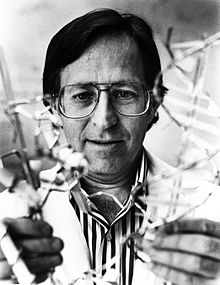Mark Ptashne
Mark Ptashne | |
|---|---|
 | |
| Born | June 5, 1940 |
| Awards | NAS Award in Molecular Biology (1979) Louisa Gross Horwitz Prize (1985) Massry Prize (1998) |
| Scientific career | |
| Fields | Molecular Biology |
| Institutions | Memorial Sloan–Kettering Cancer Center |
Mark Ptashne (born June 5, 1940[1] in Chicago) is a molecular biologist and violinist. He currently holds the Ludwig Chair of Molecular Biology at Memorial Sloan–Kettering Cancer Center in New York. He was the first scientist to demonstrate specific binding between protein and DNA, and his lifelong work has been the elucidation of the molecular mechanisms of switch between lytic and lysogenic lifecyle of bacteriophage lambda, as well as how the yeast transcriptional activator Gal4 works. He was the originator of the "ball and stick" model of transcription factor function, demonstrating in bacteria and in yeast that they typically consist of separable regions that mediate DNA binding and interaction with transcriptional activators or repressors. In 1980 he cofounded Genetics Institute, Inc. with Thomas Maniatis, which was acquired by Wyeth 1996.[2] In 1985, he was awarded the Louisa Gross Horwitz Prize from Columbia University. He won the Albert Lasker Award for Basic Medical Research in 1997, and the Massry Prize from the Keck School of Medicine, University of Southern California in 1998. He has written popular books for a wider scientific audience, including his book Genes and Signals.[3][4]
References
- ^ Bookrags.com
- ^ Genetics Institute, Inc. at History of Wyeth. Fundinguniverse.com, Retrieved 25.10.2012.
- ^ Ptashne, M (1967). "Specific Binding of the λ Phage Repressor to λ DNA". Nature. 214 (5085): 232–234. doi:10.1038/214232a0.
- ^ Ptashne, M; et al. (1980). "How the λ repressor and cro work". Cell. 19 (1): 1–11. doi:10.1016/0092-8674(80)90383-9. PMID 6444544.
Bibliography
- Ptashne, M. (2011). "Horace Judson (1931–2011)". PLoS Biology. 9 (7): e1001104. doi:10.1371/journal.pbio.1001104.
{{cite journal}}: CS1 maint: unflagged free DOI (link) - Ptashne, M (2004). A Genetic Switch: Phage Lambda Revisited (3rd ed.). Cold Harbor Spring Laboratory Press. ISBN 978-0-87969-716-7.
- Ptashne, M; Gann, A (2002). Genes and Signals. Cold Harbor Spring Laboratory Press. ISBN 978-0-87969-633-7.
- Hilts, PJ (24 February 1998). "Scientist at Work: Mark Ptashne; Virtuoso in Plucking Violin or Secrets of Genetic Switches". The New York Times. Retrieved 2009-09-28.
External links
- Mark Ptashne's personal site
- Mark Ptashne information at Cooperstown Chamber Music Festival Site
- Mark Ptashne's page at Sloan-Kettering Institute Site
- Living people
- American molecular biologists
- Harvard University faculty
- Reed College alumni
- Members of the United States National Academy of Sciences
- 1940 births
- Recipients of the Albert Lasker Award for Basic Medical Research
- Guggenheim Fellows
- Massry Prize recipients
- Harvard University alumni
- American biologist stubs
- American violinist stubs
